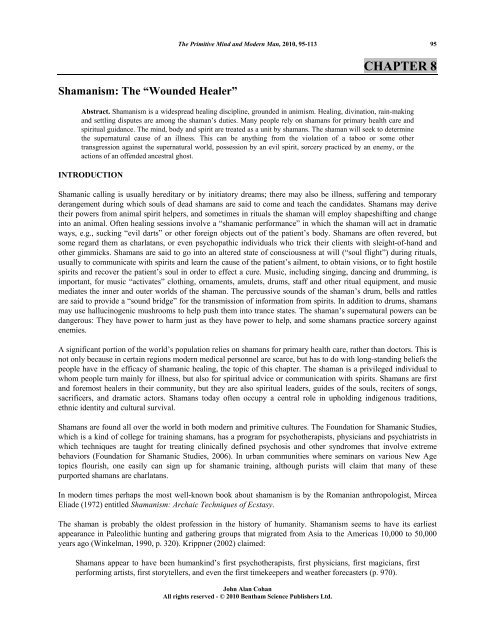chapter 1 - Bentham Science
chapter 1 - Bentham Science
chapter 1 - Bentham Science
Create successful ePaper yourself
Turn your PDF publications into a flip-book with our unique Google optimized e-Paper software.
Shamanism: The “Wounded Healer”<br />
The Primitive Mind and Modern Man, 2010, 95-113 95<br />
John Alan Cohan<br />
All rights reserved - © 2010 <strong>Bentham</strong> <strong>Science</strong> Publishers Ltd.<br />
CHAPTER 8<br />
Abstract. Shamanism is a widespread healing discipline, grounded in animism. Healing, divination, rain-making<br />
and settling disputes are among the shaman’s duties. Many people rely on shamans for primary health care and<br />
spiritual guidance. The mind, body and spirit are treated as a unit by shamans. The shaman will seek to determine<br />
the supernatural cause of an illness. This can be anything from the violation of a taboo or some other<br />
transgression against the supernatural world, possession by an evil spirit, sorcery practiced by an enemy, or the<br />
actions of an offended ancestral ghost.<br />
INTRODUCTION<br />
Shamanic calling is usually hereditary or by initiatory dreams; there may also be illness, suffering and temporary<br />
derangement during which souls of dead shamans are said to come and teach the candidates. Shamans may derive<br />
their powers from animal spirit helpers, and sometimes in rituals the shaman will employ shapeshifting and change<br />
into an animal. Often healing sessions involve a “shamanic performance” in which the shaman will act in dramatic<br />
ways, e.g., sucking “evil darts” or other foreign objects out of the patient’s body. Shamans are often revered, but<br />
some regard them as charlatans, or even psychopathic individuals who trick their clients with sleight-of-hand and<br />
other gimmicks. Shamans are said to go into an altered state of consciousness at will (“soul flight”) during rituals,<br />
usually to communicate with spirits and learn the cause of the patient’s ailment, to obtain visions, or to fight hostile<br />
spirits and recover the patient’s soul in order to effect a cure. Music, including singing, dancing and drumming, is<br />
important, for music “activates” clothing, ornaments, amulets, drums, staff and other ritual equipment, and music<br />
mediates the inner and outer worlds of the shaman. The percussive sounds of the shaman’s drum, bells and rattles<br />
are said to provide a “sound bridge” for the transmission of information from spirits. In addition to drums, shamans<br />
may use hallucinogenic mushrooms to help push them into trance states. The shaman’s supernatural powers can be<br />
dangerous: They have power to harm just as they have power to help, and some shamans practice sorcery against<br />
enemies.<br />
A significant portion of the world’s population relies on shamans for primary health care, rather than doctors. This is<br />
not only because in certain regions modern medical personnel are scarce, but has to do with long-standing beliefs the<br />
people have in the efficacy of shamanic healing, the topic of this <strong>chapter</strong>. The shaman is a privileged individual to<br />
whom people turn mainly for illness, but also for spiritual advice or communication with spirits. Shamans are first<br />
and foremost healers in their community, but they are also spiritual leaders, guides of the souls, reciters of songs,<br />
sacrificers, and dramatic actors. Shamans today often occupy a central role in upholding indigenous traditions,<br />
ethnic identity and cultural survival.<br />
Shamans are found all over the world in both modern and primitive cultures. The Foundation for Shamanic Studies,<br />
which is a kind of college for training shamans, has a program for psychotherapists, physicians and psychiatrists in<br />
which techniques are taught for treating clinically defined psychosis and other syndromes that involve extreme<br />
behaviors (Foundation for Shamanic Studies, 2006). In urban communities where seminars on various New Age<br />
topics flourish, one easily can sign up for shamanic training, although purists will claim that many of these<br />
purported shamans are charlatans.<br />
In modern times perhaps the most well-known book about shamanism is by the Romanian anthropologist, Mircea<br />
Eliade (1972) entitled Shamanism: Archaic Techniques of Ecstasy.<br />
The shaman is probably the oldest profession in the history of humanity. Shamanism seems to have its earliest<br />
appearance in Paleolithic hunting and gathering groups that migrated from Asia to the Americas 10,000 to 50,000<br />
years ago (Winkelman, 1990, p. 320). Krippner (2002) claimed:<br />
Shamans appear to have been humankind’s first psychotherapists, first physicians, first magicians, first<br />
performing artists, first storytellers, and even the first timekeepers and weather forecasters (p. 970).

















